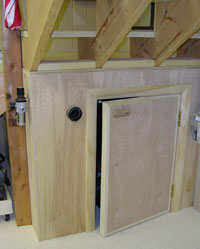
 by Steven D. Johnson
by Steven D. Johnson
Racine, Wisconsin
(Page 3 of 3)
Previous Page
1
2
3
Saving Space, Ears, and Money
With nine drawers to assemble for my new shop desk/workbench/assembly table
and clamps, and space enough to glue up only one
or two drawers at a time, I had some "tween" time in the shop and a chance to check
off some small "to do" list items.
When converting the garage and building the down to earth woodworking shop, the
stairs to the second level were built with a ninety-degree turn and landing, partly
to save space and partly so the last step at the top would land at the highest point
under the ceiling. The space under the mid-point landing was designated to house a
shop vacuum and air compressor.
Shortly after moving in, I was able to plumb air through the wall and affix a vacuum
hose fitting as you can see in the picture. Both
the vacuum and the air compressor are plugged
into switched circuits under the landing, so I can
turn either on or off from convenient wall
switches. But without a door on the
landing "cubbyhole," the noise from the shop
vacuum was no different than before. The
reduction of noise was to be a primary benefit of
sequestering two of the noisiest machines in the
shop.

|
|
The "Hobbit" door on
the stairway cubbyhole.
|
Finally, with spare time and scraps of wood, I made a standard 1-1/4" thick door,
albeit much shorter – sort of a Hobbit door. It is essentially a hollow-core door, a
sandwich of plywood with expanded foam as the meat of the sandwich. Regular
door hinges were set into hand-cut mortises. Instead of a doorknob, which would
have been overkill, I used a butterfly catch and a drawer pull handle that matches
the drawer pulls on all the other cabinets in my shop.
Prior to installing the shop vacuum in its cubbyhole, the
beast emitted a high-pitched 81 dB of sound. Now,
safely ensconced underneath the landing, a mere 68 dB
of sound is measured from the same distance (for a
primer on shop noise abatement, see the article ([click
here] "Sound Safety Tips"). The air compressor, which
literally "rocked the shop" before, is also significantly
quieter.
Now, I can hook up a hose anytime I need the vacuum
or compressor, and hide the hose away when not in
use. Neither machine is taking up valuable floor space.
I use disposable filter bags in the vacuum, and when
full, it is quite simple to roll the vacuum out from under
the landing, replace the bag, and roll it back in. All in all, the set-up is working
pretty well.
Most woodworkers agree there is always a driving desire to use every nook and
cranny in a shop wisely – space is always at a
premium. The small space under the short
lower section of stairs was just such a space,
so in a matter of minutes, I cut a piece of 1/4"
plywood, added boards around the sides to
make a sort of "lipped" tray, and attached five
casters to the underside.
The fifth caster was
put in
the
middle
of the
tray to prevent sagging.
This little rolling cart
now holds my "go-bag" tools – the bag I grab
when neighbors and friends have emergencies
and need help. There is also room for
my "electrical go-bag," a coil of air hose, and
shop vacuum attachments. When I need
something, the rolling tray is easy to access. At
all other times, this stuff is out of the way.
Upstairs the shop is far from pretty, but it is getting better. Bit by bit I am adding
insulation and covering the walls and ceiling. My old store-bought and modified
workbench has found its seventh life now as a sharpening station.
Installing the insulation is pretty
easy, but attaching the OSB (the
cheapest thing I could think of) to
the roof rafters is a very difficult one-person job… at least for this one
person. I started with the gable-end
walls – insulation, OSB, and paint.
That was not too difficult. But then I
started on the east-side rafters.
Holding a sheet of OSB overhead at
an angle while fastening it is really a
job for four or more hands. And yes,
I ran out of paint, so I only painted
the section above the bench. Still, it
helps with the lighting.
There is still a ways to go. One of my original goals was to have a shop so tight, so
well insulated, that I could heat it with my coffee mug warmer and a candle. I’m
not quite there yet, but with the sub-freezing temps here, I am pleased at how little
additional heat I have to inject. So far (fingers crossed and knocking on wood) my
utility bills are half what they were last year in my old shop. Finishing the upstairs
insulation is a high priority based on this early success.
Stick around for 2012. It is going to be an exciting year with new projects,
techniques, and tools. And thanks, everyone, for all your support. Woodworkers
rule! Happy New Year!
(Page 3 of 3)
Previous Page
1
2
3
Steven Johnson is retired from an almost 30-year career selling medical equipment and
supplies, and now enjoys improving his shop, his skills, and his designs on a full time basis
(although he says home improvement projects and furniture building have been hobbies for most of his
adult life).
Steven can be reached directly via email at sjohnson13@mac.com.
Return to Wood News front page
